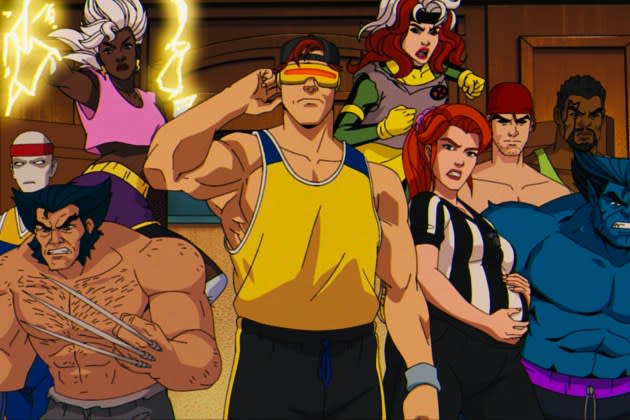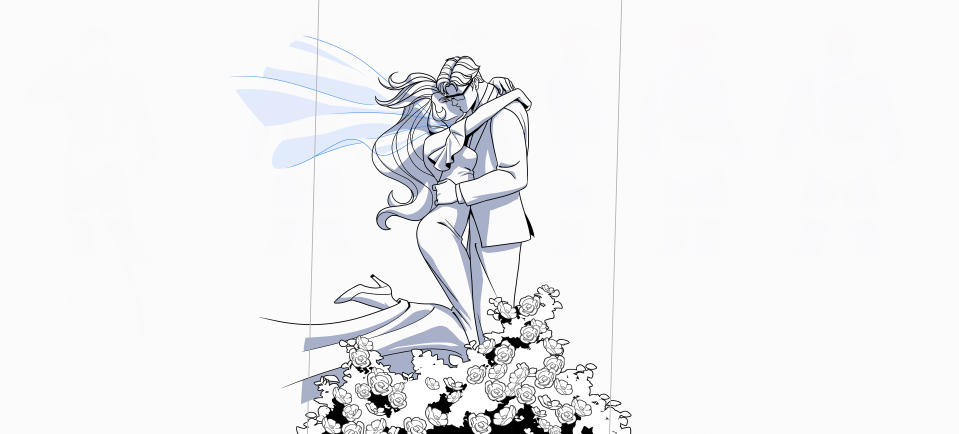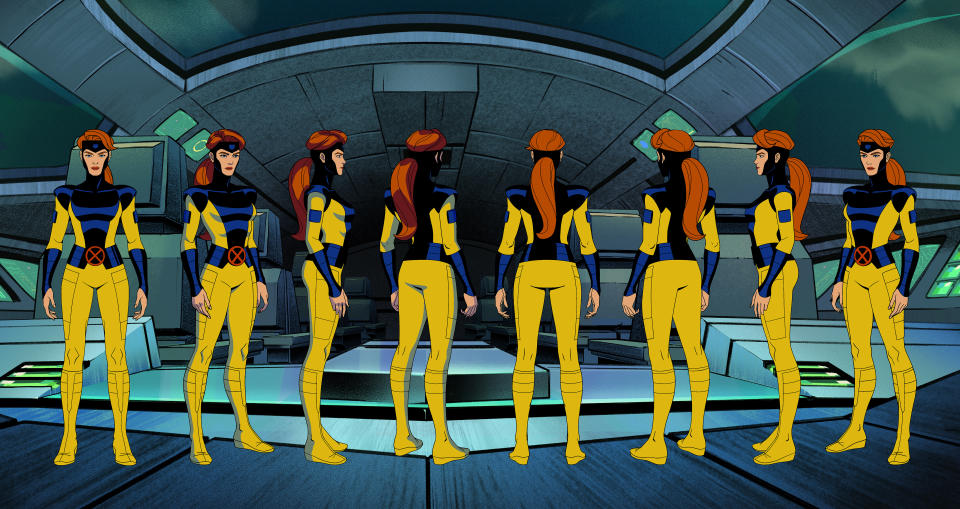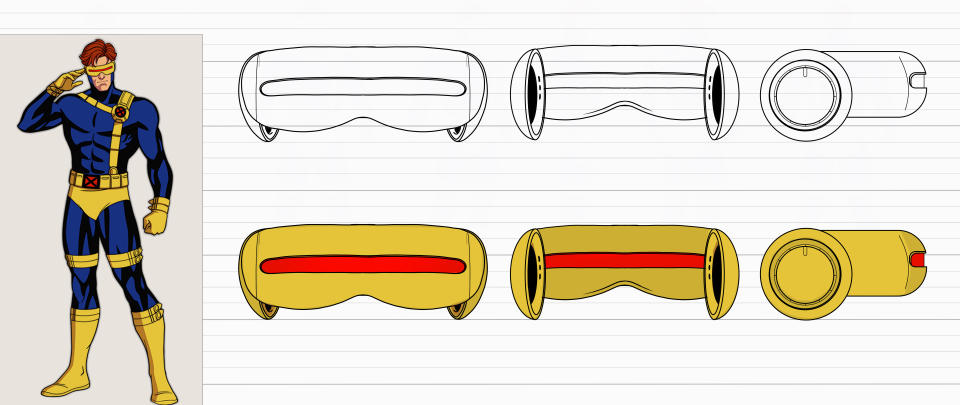‘X-Men ’97’ and ‘The Animated Series’ Creators — Then and Now — Talk Revival, Playing With ‘Disney Money’ and Morph’s Nonbinary Backlash (EXCLUSIVE)

“What the hell’s a mutant?”
Over 30 years ago, Canadian voice actor Cal Dodd auditioned for Project X, an animated show at the now-defunct Fox Kids – a children’s programming block known in the ‘90s for Saturday morning cartoons. He was up for a character called Wolverine, and he read lines for a scene with someone named Sabretooth.
More from Variety
'The Masked Singer' Reveals Identity of Afghan Hound: Here Is the Celebrity Under the Costume
'X-Men '97' Creator Beau DeMayo Fired Ahead of Disney+ Series Premiere
“Is this an animal cartoon?” he recalls wondering as he stood in a vocal booth in Toronto.
Meanwhile in the U.S., Alison Sealy-Smith couldn’t believe she was stooping so low for her role.
“I had no idea what this was about,” she says. “They told me it was a cartoon. I felt a little quiver because I was supposed to be this serious actress. I was out in Connecticut doing Shakespeare at the time. I had no idea what I was getting myself into.”
Lenore Zann had just wrapped up a lead role in an Off-Broadway play and skipped the first auditions for Project X.
“Like Alison, I considered myself a — air quotes — ‘serious actress.’ I did movies, television, theater, radio dramas,” she says. “They were looking for a woman with a low, husky, sexy voice who could do a Southern accent.”
Nobody thought Project X, the codename for “X-Men: The Animated Series,” would become an enduring hit that would catapult the mutant outsiders to superhero stardom in the late ‘90s. It created an appetite from fans to see their beloved characters brought to life on the big screen, something that would soon become a reality with Fox’s “X-Men” movies and Disney’s Marvel Cinematic Universe. Now, decades later, “X-Men: The Animated Series” is being revived on Disney+ with the upcoming series “X-Men ‘97,” premiering March 20.

Whether it’s in the pages of Marvel comics in the 1960s, on cable TV in the 1990s or streaming on Disney+ in the 2020s, the message of the X-Men remains the same: They fight for people who are different in a world that fears them. More than 25 years after “X-Men: The Animated Series” finished its run on Fox Kids, “X-Men ‘97” continues the story with many of the same creators and voice actors – but now with a bigger budget and team. A trio of the original creatives behind “The Animated Series” teamed up with executive producer Brad Winderbaum, director Jake Castorena and showrunner Beau DeMayo on “X-Men ‘97.” However, much like the X-Men’s never-ending quest for mutant rights, the show faced challenges to get here.
On March 12, news broke that Marvel had fired DeMayo early last week, and the company notified cast and crew that he was no longer a part of the show. The writer-producer had finished all of his work on Seasons 1 and 2 of “X-Men ‘97,” but no reason was given for his firing, leaving many fans wondering what had happened just weeks ahead of the premiere.
“He did excellent work writing Seasons 1 and 2, and I can’t wait for fans to see the series,” Winderbaum says. “The entire team came together to create a revival worthy of the X-Men’s 60-year legacy. From Stan and Jack, to Claremont, to the Lewalds, we all truly were standing on the shoulders of giants.”
DeMayo had been active on his personal Instagram, sharing behind-the-scenes tidbits about “X-Men ‘97,” but his account was deleted ahead of news of his firing. Along with “X-Men” animation, DeMayo, an openly gay Black man, posted many shirtless selfies at the gym or working out. For a time, he ran a non-explicit OnlyFans account under the username “Beaunlyfans,” and he was profiled by Out magazine in 2022 as “the sexy, gay Marvel and showrunner to know.” He had also written on Marvel Studios’ “Moon Knight” series and is one of the screenwriters of the long-delayed upcoming “Blade” film.
Variety had scheduled an interview with DeMayo for this story, but it was postponed on March 4, due to the showrunner being under the weather, and canceled on March 6. A rep for DeMayo did not return calls for comment.
Even before he was fired, DeMayo wasn’t a stranger to controversy in the lead up to “X-Men ‘97.” Last year, he deleted his Twitter account due to fan backlash over claims of “whitewashing” the mutant Sunspot, who is portrayed in the comics biracial-Brazilian, Gui Agustini, a light-skinned Brazilian actor, was cast to voice the hero, which drew some fans’ ire. A similar backlash occurred when DeMayo revealed that Morph, a popular, shapeshifter from “The Animated Series,” was reimagined to be nonbinary in “X-Men ‘97.”
DeMayo didn’t attend the Hollywood premiere of “X-Men ‘97” on March 13, the day after news broke about his firing. A sudden split like this so close to the premiere of a show is highly unusual. Last year, Marvel let go of the head writers and directors of the upcoming series “Daredevil: Born Again” mid-production, but that was announced after the writers and actors strikes that shut down Hollywood. “Moon Knight,” “She-Hulk” and “Secret Invasion” had their own showrunner issues, but nothing this late in the promotional cycle.
In an interview with Variety on Feb. 29, just days before DeMayo’s firing was made public, original showrunner Eric Lewald said, “We love and respect Beau DeMayo for taking on this job. He’s one of those superfans who knows our show better than we do. He said, ‘We want it to be an extension. We want it to be like the next episode of the show that all of us on staff love and grew up with.’ They could have done a spinoff or a different character or team, and yet they chose to be an extension of our show, which just is ridiculously gratifying to us.”

When “X-Men: The Animated Series” debuted in 1992, Marvel was a completely different company than it is today. The MCU didn’t exist; “Howard the Duck” was the only feature film adapted from its comics; “Spider-Man” hadn’t swung onto TV screens for nearly a decade; Tom Holland wasn’t even born yet. Nobody outside of the comic book world was familiar with the X-Men, not even its eventual showrunner.
By the ‘80s, the X-Men topped Marvel comic book sales, but hadn’t made the jump to other media. The mutant teammates regularly sold out at comic book shops, but no network executive wanted to take a chance on the oddball characters — until Margaret Loesch became president of Fox Kids. She hired a small but mighty team, consisting of Lewald; his wife, writer Julia Lewald; and director Larry Houston, to create the first season of “X-Men: The Animated Series” in just seven months.
Fox Kids execs asked Eric Lewald to have a show bible done in two weeks, and Houston made the now-iconic opening credits in a weekend. But the only thing tighter than the timeline was the budget.
“We felt like a bunch of friends in a garage slapping something together as fast as we could,” Eric Lewald says. “What Larry thought was a good piece of art went out in two minutes. We didn’t have a writers’ room; we had our dining table.”
South Korean production company AKOM handled the animation, while the voice actors recorded in Canada. That meant audio cassettes traveled by mail from Toronto to Los Angeles, and the finished animation took between three and four months to arrive from Korea. The first rough footage was not “air-able,” Houston says, so Loesch had to call Fox advertisers and explain that “The Animated Series” would have a sneak peek on Halloween 1992 and delay its official premiere to early 1993.
“She had to fight those fights and stood her ground,” Eric Lewald says. “If she hadn’t, the show would have died.”

Like a dark phoenix, “X-Men: The Animated Series” rose from the shoestring, lightspeed production and became one of the most beloved Marvel shows and Saturday morning cartoons ever. Dodd voiced Wolverine, a stocky Canadian with adamantium claws; Sealy-Smith was Storm, a regal African woman who could control the weather; and Zann played Rogue, a Southern belle with a power-absorbing touch. As a team, the X-Men fought for equal rights for mutants and humans in a world that hated and feared outsiders. The show’s popularity persisted, even after it was canceled in 1997. Since Disney acquired Fox in 2019, MCU fans have been clamoring for the X-Men to join the interconnected universe with Captain America, Thor and Spider-Man. With “X-Men ’97,” they’re one step closer to that dream.
When Disney+ launched in 2019, Marvel Studios immediately looked to continue “The Animated Series” story. Winderbaum, Marvel Studios’ head of streaming, television and animation, pitched “X-Men ‘97” in the early days of Disney+ after the MCU’s first animated series “What If…?” had been greenlit. Like many of the artists who worked on the “X-Men” continuation, he was a diehard fan of the original. When the new show entered development, Winderbaum’s first call was to Eric and Julia Lewald and Larry Houston.
The original creative trio returned for “X-Men ‘97,” as did voice actors Dodd, Sealy-Smith, Zann and a handful of others. The new show picks up after the 1997 series finale, as X-Men founder Charles Xavier is believed to be dead and his fiercest rival, the metal manipulator Magneto, has control of Xavier’s last will and testament — which includes ownership of the team. Now Wolverine, Cyclops, Jean Grey, Rogue, Storm and their teammates must keep up Charles’ fight — now with sharper colors and more stylish animation.
“When we did our show, we did the best we could with the money we had. But this current show, they’ve got Disney money,” Houston says. “Disney money makes stuff really good.”
Director Jake Castorena, who grew up watching “X-Men: The Animated Series” on Pizza Hut-distributed VHS tapes, used some of Houston’s original storyboards 30 years later to include scenes the animator had to cut. Houston passed down “valuable tools of the trade” to Castorena’s team. “The Animated Series,” which already looked advanced for its time, got a fresh coat of adamantium with “X-Men ’97.”
The spirit of the ‘90s lives on in the new show, even a generation later. The motto “fresh, but familiar” from his initial pitch landed Castorena the job, and his animation team maintained the retro ‘90s style in “X-Men ‘97.” His team created a VHS-inspired filter to apply to the animation and “guardrails” to keep a ‘90s vibe, despite having new-age tech.
“Part of the design of the show was to reconstruct people’s memory of it,” Winderbaum says. “When we designed Mister Sinister for the new series, we tried to emulate the designs, textures and backgrounds as much as possible. He had all these tendrils coming out of his back, so they could never move him a lot. As we’re making the show today, we’ve got the ability to move him all over the place, but we had to put artificial limiters on ourselves to make it feel like he was the same Sinister from the OG show.”

Castorena’s “X-Men ‘97” philosophy was to “use mutant abilities in ways we’ve never seen before.” He came up with the idea of Gambit charging up Wolverine’s adamantium claws with purple kinetic energy, seen during a battle with massive robot Sentinels in the show’s first trailer. During that same fight, shapeshifter Morph transforms into the bulbous bad guy Blob to bounce Wolverine onto a Sentinel from his trampoline-like belly.
Blob’s cameo in the premiere is far from the only guest character. The original show featured appearances from Marvel heroes like Captain America, Thor, Black Panther, Doctor Strange and more. “X-Men ‘97” is no different. The trailer already alluded to Spider-Man (who had his own ‘90s cartoon) with a Daily Bugle newspaper. Even though “X-Men ‘97” doesn’t take place in the main timeline of the MCU, there are plenty of possibilities, perhaps even from the “Iron Man” and “Silver Surfer” ’90s cartoons, for crossovers.
“It’s exactly the same level of cameos as the original series,” Winderbaum says. “Even though ‘X-Men ‘97″ is not in the sacred timeline, there is a universe of ‘90s cartoons that we know. Because of ‘Loki’ and every other multiverse story, we know that if your brain wants to go there, you know there’s always potential for connections.”
Before the MCU, “X-Men: The Animated Series” paved the way and cultivated a fanbase for a live-action Marvel film. In the late ‘90s, Fox brought in several writers, like Christopher McQuarrie, Joss Whedon and Ed Solomon, to take a pass at an “X-Men” movie. After many revisions and overhauls, director Bryan Singer and Tom DeSanto received story credit on the first “X-Men” film, which was released in 2000, and David Hayter, an actor, producer and Singer’s former assistant, earned the sole screenwriting credit. Hayter used his love of the “X-Men” comics to steer the movie’s script amid the revolving door of writers and lack of studio knowledge about the heroes.
“Bryan Singer has never read an ‘X-Men ’comic book in his life, but he watched every single episode of that series to prepare him for the movie,” Hayter says. “The powers that be have always underestimated the effectiveness of X-Men. They didn’t think the animated show or the movie was going to be a hit. There was always this concern that it was too strange, too serious — the storylines were too outrageous. But those of us who are fans know how compelling the X-Men are and how those unbelievable, otherworldly stories are combined with real psychology, pain and humanity.”
Hugh Jackman, Halle Berry, James Marsden and more suited up for Singer’s realistic take on “X-Men.” Instead of the colorful costumes of “The Animated Series,” the live-action team wore black leather suits. The movie was an unexpected hit, and eventually spawned two sequels, four prequels and two trilogies for Wolverine and Deadpool.
The Lewalds and Houston were not involved with the live-action films, but Eric Lewald says “absolutely 95%” of Singer’s first two movies were based on “our vision of what the X-Men should be.”
The “Animated Series” voice actors didn’t think their live-action counterparts portrayed the characters the same way. Sealy-Smith and Berry’s Storm and Zann and Paquin’s Rogue were “completely different,” the two voice actors say.
“There wouldn’t have been movies without our five-year animated series. That’s a well-known fact,” Dodd says, before quipping, “Wolverine had gained a foot in height, and had an Australian accent, no doubt.”

In the decades between “X-Men: The Animated Series” and “X-Men ‘97,” a lot has changed, but some things have stayed sadly similar. When the show first aired, none of the voice actors or creators knew how widespread the fanbase was. It wasn’t until the rise of social media and comic conventions that the “X-Men” team learned the truth.
“We didn’t know how successful the show was at the time,” says Zann. “Julia Lewald would tell us the story of going into Fox Kids and seeing fan mail in bins going right up to the ceiling and all the way down the halls. She was told, ‘That’s the fan mail for “X-Men” from around the world. ’The sad thing is, we never received it. The actors never got it, and we were never able to write back to these fans.”
Now, the actors can meet their adoring fans and chat with them over social media. Dodd has met thousands of people named Logan (inspired by Wolverine’s real name), and receives ultrasound pictures of future Logans-to-be.
“We’ve had fans come up and say, ‘I have a philosophy Ph. D because of Beast,” says Julia Lewald. “Or ‘I loved Gambit, that’s why I speak French now.’”
After the trailer for “X-Men ‘97” debuted last month, however, some fans took to social media to decry changes made to Morph, a fan-favorite shapeshifter. In the series premiere of “X-Men: The Animated Series,” Morph was introduced as an original character, based partly on the comic-book hero Changeling, and could transform his appearance and voice to perfectly impersonate anyone. In a shocking twist, Morph was killed off in the premiere, but he was so loved by fans that the “Animated Series” team revived him one season later. At first, Morph was brainwashed by the evil Mister Sinister, but he later flipped back to the good side and rejoined his friends.
Morph returns to the team in “X-Men ‘97” with a new look. Instead of appearing as a brunette man, Morph is now nonbinary with a bald head and white, mask-like face. DeMayo confirmed the change in an interview before he was fired, but after the first trailer dropped, some fans took to X/Twitter and called it a “woke” change for the sake of diversity.

Now, Morph’s creators are pushing back on the criticism, saying the hero being portrayed as nonbinary aligns with their original designs.
“For me, the word ‘nonbinary’ is the same as the word ‘shapeshifter,’” Houston says. “Every character that can change from one gender to another, or from human to animal, that’s just another word for ‘shapeshifter’ for me.”
Eric Lewald points to Morph’s resurrection in Season 2 of “The Animated Series,” when the former teammate transforms into Rogue, Storm and Jean Grey to get revenge on the X-Men.
“He attacks Wolverine, his closest friend, in the most dramatic way by turning into Jean Grey and putting his hand on Wolverine’s neck and leaning in for a kiss. That’s as nonbinary as you can get. It’s Morph turning into a woman and coming onto Wolverine to freak him out,” he says. “It was all there in Morph’s character. Now it’s become such a social thing that I think people will be more sensitive to how it’s used. That’s the only difference. We didn’t see a problem in reading him and didn’t feel he was any different.”
It’s not lost on the creators that the same message the X-Men extol, fighting for others and uniting over their differences, is just as relevant today as it was in the ‘90s. Whether it’s in the 1990s or the 2020s, the X-Men have an important place in TV and pop culture, and now a different generation can experience their fight for good.
“Did we teach you people nothing? Were you not watching?” Julia Lewald says. “Did we not figure out how to be nice to each other and how to get along? It’s very odd to feel like we are still dealing with the same issues that we were dealing with 30 years ago. It’s painful.”
Zann, the voice actor who once questioned why she’d be on the show at all, echoes the same frustration — but also offers hope for the future.
“That message needs to be spread throughout the world right now,” she says. “I hope we can bring hope to people and to children so they can look to the future and go, ‘I have a place in this world. I belong, and it’s OK to be different.’”
The first two episodes of “X-Men ’97” premiere on Disney+ on March 20, with new episodes dropping weekly on Wednesday.
Best of Variety
'House of the Dragon': Every Character and What You Need to Know About the 'Game of Thrones' Prequel
25 Groundbreaking Female Directors: From Alice Guy to Chloé Zhao
Sign up for Variety’s Newsletter. For the latest news, follow us on Facebook, Twitter, and Instagram.
